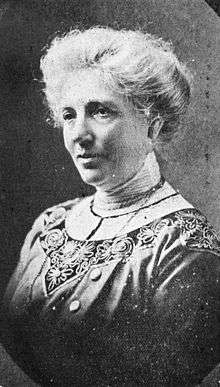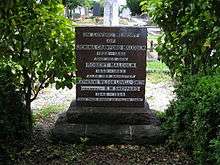Kate Sheppard
| Kate Sheppard | |
|---|---|
 Kate Sheppard, photographed in 1905 | |
| Born |
Catherine Wilson Malcolm 10 March 1847 Liverpool, England |
| Died |
13 July 1934 (aged 87) Christchurch, New Zealand |
| Other names | Katherine Wilson Malcolm |
| Home town | Liverpool |
| Spouse(s) |
Walter Sheppard (m. 1872) William Lovell-Smith (m. 1925) |
| Children | Douglas Sheppard (b. 1880) |
Katherine Wilson "Kate" Sheppard (10 March 1847 – 13 July 1934)[lower-alpha 1] was the most prominent member of New Zealand's women's suffrage movement and was the country's most famous suffragette. She also appears on the New Zealand ten-dollar note. Since New Zealand was the first country to introduce universal suffrage in 1893,[3] Sheppard's work has had a considerable impact on women's suffrage movements in several other countries.
Early life
Kate Sheppard was born Catherine Wilson Malcolm in Liverpool, England to Scottish parents Jemima Crawford Souter and Andrew Wilson Malcolm.[4] She generally preferred to spell her given name "Katherine", or abbreviate it to "Kate". She received a good education, and was noted for her intellectual ability and broad knowledge. For a time she lived with her uncle, a minister of the Free Church of Scotland at Nairn.[3] In 1869, several years after her father's death, Sheppard and her siblings immigrated with their mother to Christchurch, New Zealand. She married Walter Allen Sheppard three years later, and their only child, Douglas, was born on 8 December 1880.[4]
In 1885, Kate Sheppard became involved in establishing the New Zealand Women's Christian Temperance Union, part of the larger temperance movement.[3] Sheppard's involvement arose primarily from her religious beliefs, which she had derived from her uncle.[4]
Women's suffrage movement
Discovering that much of the support for moderation came from women, the Temperance Union increasingly became active in advocating the cause of women's suffrage, an area in which Sheppard quickly became prominent. Her interest in women's suffrage, however, went beyond practical considerations regarding temperance: her views were made well known with her statement that "all that separates, whether of race, class, creed, or sex, is inhuman, and must be overcome."[5] Sheppard proved to be a powerful speaker and a skilled organiser, and quickly built support for her cause.[4]
Sheppard helped introduce the first suffrage bill in 1887.[5] In 1888, she published a pamphlet entitled Ten Reasons Why the Women of N.Z. Should Vote which championed the reasons women should be allowed to vote and also displayed her "dry wit and logical approach."[3]
The Temperance Union presented a petition in favour of women's suffrage to Parliament in 1891. It was supported in Parliament by John Hall, Alfred Saunders, and the Premier, John Ballance. Sheppard played a considerable part in organising the petition. A second petition, larger than the first, was presented the following year, and a third, still larger, was presented in 1893. That year, a women's suffrage bill was successfully passed, granting women full voting rights. Sheppard herself was widely acknowledged as the leader of the women's suffrage movement.[4][6]
Sheppard had no time to rest, however, as the 1893 election was only ten weeks away. Along with the Temperance Union, she was highly active in getting women to register as voters. One of her largest detractors was the liquor industry, fearing for its continued business.[6] Despite the short notice to register women voters, nearly two-thirds of women cast a vote.[4]
National Council of Women
The year after women's suffrage was achieved, Sheppard returned to England for a short time, where she met prominent British suffragettes and gave a number of speeches. Upon her return home, she was elected president of the newly founded National Council of Women of New Zealand which had considerable influence on public opinion. Sheppard later became involved in the production of the council's newspaper, the White Ribbon.
Many ideas that Sheppard promoted were related to improving the situation and status of women – in particular, she was concerned about establishing legal and economic independence of women from men. She was not wholly occupied with advancing women's rights, however, also finding time to promote political reforms such as proportional representation, binding referendums, and a Cabinet elected directly by Parliament.
Later life

In 1903, Sheppard stepped down from her positions at the National Council of Women due to ill health. Later that year, she and her recently retired husband moved to England, intending to retire there. She briefly stopped in Canada and the United States, meeting American suffragist Carrie Chapman Catt. In London, she was active in promoting women's suffrage in Britain, but was soon unable to continue her work due to her deteriorating health.
In 1904, Sheppard returned to New Zealand. She remained relatively inactive in political circles, but continued to write. While she did not recover her former energy, her health was no longer declining, and she continued to influence the New Zealand women's movement to a great extent. In 1916, Sheppard and a group of other prominent suffragettes were able to revitalise the National Council of Women, which had gone into recess.
In 1925, Sheppard married William Sidney Lovell-Smith, her first husband having died in 1915 in England. Lovell-Smith died only four years later. Kate Sheppard herself died in Christchurch on 13 July 1934. She is buried at Addington Cemetery in a family grave.
Commemoration

Sheppard is considered to be an important figure in New Zealand's history. A memorial to her exists in Christchurch, and her image appears on New Zealand's ten-dollar note. The Fendalton house at 83 Clyde Road where the Sheppards lived from 1888 to 1902, known as the Kate Sheppard House, is registered by the New Zealand Historic Places Trust as a Category I heritage building, as many of the events relevant to women's suffrage happened there.[7]
A play about Sheppard and the Temperance movement 'O Temperance', written by acclaimed New Zealand playwright Mervyn Thompson, was first performed in 1972 at the Christchurch Court Theatre. Actress Judy Cleine played Sheppard. In 2016 a new production entitled "That Bloody Woman" is touring New Zealand and also playing at Christchurch's Court Theatre. The show tells Kate Sheppard's story as a rock/punk musical.
One of the streets in Wellington's parliament precinct is named after her. Kate Sheppard Place is a short one-way street running from Molesworth Street opposite Parliament House to the intersection of Mulgrave Street and Thorndon Quay. A Kate Sheppard Avenue also exists in the Auckland suburb of Northcross.
Several New Zealand schools have houses named after her. In the Greater Christchurch area alone, a Sheppard house exists at Christchurch South Intermediate, Cashmere High School,[8] Christchurch Girls' High School,[9] and Rangiora High School.[10]
In 1993, the centenary of women's suffrage in New Zealand, a group of Christchurch women established two memorials to Sheppard: the Kate Sheppard National Memorial, on the banks of the Avon River, and the Kate Sheppard Memorial Trust Award, an annual award to women in research.[11]
In 2014, eight intersections near Parliament in Wellington were fitted with green pedestrian lights depicting Kate Sheppard.[12]
In 2016, a memorial lecture in her name was initiated – the Kate Sheppard Women of Influence Lecture. The inaugural lecture was held at Massey University's Wellington campus and the speaker was Stacey Shortall. It is planned to be an annual event, sponsored by Westpac bank.[13]
See also
- List of suffragists and suffragettes
- List of women's rights activists
- Timeline of women's suffrage
- Women's suffrage in New Zealand
- Women's suffrage organisations
Notes
- ↑ Sources such as the Dictionary of New Zealand Biography,[1] give a birth year of 1847; others such as the Encyclopaedia of New Zealand (1966) give a birth year of 1848.[2]
References
- ↑ Malcolm 2012.
- ↑ Roth 1966.
- 1 2 3 4 Fleischer, Jeff (2014). Rockin' the Boat: 50 Iconic Revolutionaries from Joan of Arc to Malcolm X. San Francisco, California: Zest Books. pp. 151–154. ISBN 9781936976744.
- 1 2 3 4 5 6 Malcolm, Tessa K. (30 October 2012). "Sheppard, Katherine Wilson". Dictionary of New Zealand Biography. Te Ara – The Enclyclopedia of New Zealand. Retrieved 21 May 2013.
- 1 2 Lusted, Marcia Amidon (March 2009). "International Suffrage". Cobblestone. 30 (3): 40. ISSN 0199-5197. Retrieved 24 June 2015. (subscription required (help)).
- 1 2 Adas, Michael (2010). Essays on Twentieth-Century History. Philadelphia, Pennsylvania: Temple University Press. pp. 91–92. ISBN 9781439902714.
- ↑ Kate Sheppard House.
- ↑ "House Competitions". Cashmere High School. Retrieved 29 November 2011.
- ↑ "School houses – Student information". Christchurch Girls' High School. Retrieved 29 November 2011.
- ↑ "Houses". Rangiora High School. Retrieved 29 November 2011.
- ↑ Wellington, Victoria University of. "Scholarship detail". Victoria University of Wellington. Retrieved 2016-03-13.
- ↑ Maoate-Cox, Daniela (11 September 2014). "Kate Sheppard lights encourage voting". Radio New Zealand. Retrieved 20 September 2016.
- ↑ "Kate Sheppard Women of Influence Lecture". www.westpac.co.nz. Retrieved 2016-04-06.
Sources
- Malcolm, Tessa K. (30 October 2012). "Sheppard, Katherine Wilson". Dictionary of New Zealand Biography. Te Ara – the Encyclopedia of New Zealand. Retrieved 21 May 2013.
- Roth, Herbert Otto (1966). "Sheppard, Katherine Wilson". An Encyclopaedia of New Zealand.
- "Kate Sheppard House". Register of Historic Places. New Zealand Historic Places Trust. Retrieved 21 May 2013.
- "Brief history – women and the vote". New Zealand Ministry for Culture and Heritage. 20 December 2012. Retrieved 21 May 2013.
- Brewerton (20 December 2012). "Kate Sheppard". New Zealand Ministry for Culture and Heritage. Retrieved 21 May 2013.
- "A brief history of women and the vote in New Zealand" (PDF). Retrieved 21 May 2013.
External links
| Wikimedia Commons has media related to Kate Sheppard. |
| Wikiquote has quotations related to: Kate Sheppard |
- Brief biography at NZ Edge
- "Kate Sheppard's Story" at NZGirl
- "Celebrating Women's Suffrage 106 Years On" at NZine